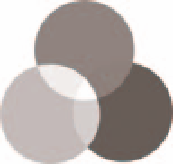Graphics Programs Reference
In-Depth Information
Grayscale
Color
Photoshop will throw away the RGB (Red, Green, Blue) or CMYK (cyan,
magenta, yellow, black) color channel information, creating a much smaller
i le, and convert the image colors into black, white and 256 values of gray
tones. Photoshop determines the tonalities each color will render with a
pre-calculated formula (algorithm) in order to create the resulting grayscale
image. This method of conversion attempts to simulate the look and feel of
Kodak Plus-X i lm. While this method is exceptionally fast and easy to use, the
photographer loses color information that cannot be recreated, as well as
control and input in the conversion process. The results are usually relatively
pleasing for many images, but rarely produce the optimal image the i ne art
photographer will be looking for. One can, of course, greatly improve the
conversion by adjusting tone and contrast, as well as shadows and highlight
information with adjustment layers and digital darkroom editing.
Advantages:
1.
Fast
2.
Moderately ef ective
3.
Creates smaller i les
Disadvantages:
1.
Loss of control
2.
Moderately ef ective
3.
Discards color channels
4.
Discards image data
5.
Limits post-processing, i ltration, gamut, etc.




Search WWH ::

Custom Search